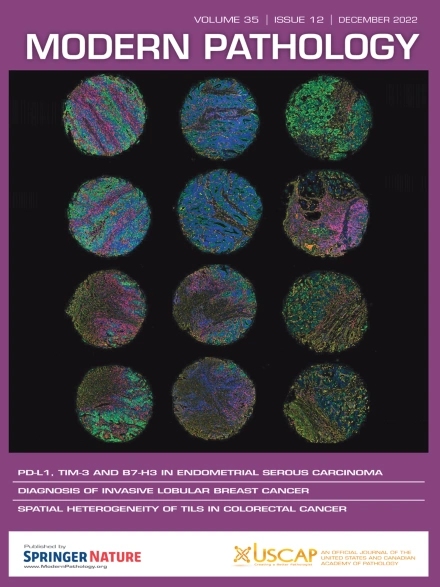具有不同 HER2 荧光原位杂交阳性模式的浸润性乳腺癌的临床病理特征和随访结果:来自一家学术机构的经验。
IF 7.1
1区 医学
Q1 PATHOLOGY
引用次数: 0
摘要
人表皮生长因子受体 2(HER2)阳性乳腺癌(BC)包括一系列分子亚型,其特征是 HER2/CEP17 比率和 HER2 拷贝数各不相同,从而影响了抗 HER2 治疗的反应。这项研究将HER2荧光原位杂交(FISH)阳性患者分为三个不同的组别:高拷贝数第一组(G1-HC:比率≥2,拷贝数≥6)、低拷贝数第一组(G1-LC:比率≥2,拷贝数≥4和本文章由计算机程序翻译,如有差异,请以英文原文为准。
Clinicopathologic Characteristics and Follow-Up Outcomes of Invasive Breast Carcinoma With Different Positive HER2 Fluorescence In Situ Hybridization Patterns: Experience From a Single Academic Institution
Human epidermal growth factor receptor 2 (HER2)-positive breast carcinoma (BC) encompasses a spectrum of molecular subtypes, characterized by varying HER2/CEP17 ratios and HER2 copy numbers, influencing responses to anti-HER2 therapy. This study stratified HER2 fluorescence in situ hybridization (FISH)-positive patients into 3 distinct groups—group 1 with high copy number (G1-HC: ratio ≥2, copy number ≥6), group 1 with low copy number (G1-LC: ratio ≥2, copy number ≥4 and <6), and group 3 (G3: ratio <2.0, copy number ≥6.0)—and evaluated their clinicopathologic features, response to anti-HER2 therapy, and outcomes. In a cohort of 2702 continuous primary BCs, G1-HC BCs accounted for 304 cases (11.3%), G1-LC for 37 cases (1.4%), and G3 for 75 cases (2.8%). G1-HC BCs were associated with younger age, higher tumor grade, and estrogen receptor negativity compared with G1-LC BCs. Furthermore, G1-HC BCs exhibited increased progesterone receptor negativity and HER2 immunohistochemistry 3+ compared with G1-LC and G3 BCs. Analysis of the subgroup of HER2 immunohistochemistry 2+-only cases (n = 166) showed similar results. Notably, G1-HC patients exhibited significantly enhanced responses to anti-HER2 neoadjuvant chemotherapy compared with G1-LC and G3 patients. Conversely, G1-LC patients displayed a lower likelihood of disease-free status compared with G1-HC and G3 patients, albeit with no significant differences in overall survival, distant metastasis, or local recurrence among the groups. These findings offer valuable clinicopathologic insights into different HER2 FISH positive subgroups, potentially informing future criteria for interpreting HER2 FISH results.
求助全文
通过发布文献求助,成功后即可免费获取论文全文。
去求助
来源期刊

Modern Pathology
医学-病理学
CiteScore
14.30
自引率
2.70%
发文量
174
审稿时长
18 days
期刊介绍:
Modern Pathology, an international journal under the ownership of The United States & Canadian Academy of Pathology (USCAP), serves as an authoritative platform for publishing top-tier clinical and translational research studies in pathology.
Original manuscripts are the primary focus of Modern Pathology, complemented by impactful editorials, reviews, and practice guidelines covering all facets of precision diagnostics in human pathology. The journal's scope includes advancements in molecular diagnostics and genomic classifications of diseases, breakthroughs in immune-oncology, computational science, applied bioinformatics, and digital pathology.
 求助内容:
求助内容: 应助结果提醒方式:
应助结果提醒方式:


